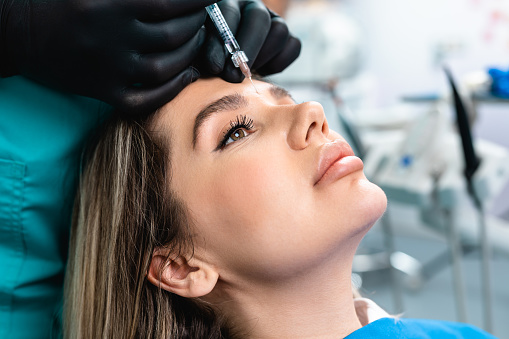
Dermal fillers, sometimes referred to as soft tissue fillers, are chemicals that are injected beneath the skin’s surface to increase volume and fullness.
Table of Contents
The following substances are used in dermal fillers:
- Calcium hydroxyapatite is a mineral-like substance that occurs naturally in bones.
- Hyaluronic acid is found in certain bodily fluids and tissues and contributes to plump skin.
- Polyalkylimide is a clear gel that is biocompatible.
- Polylactic acid boosts collagen formation in the skin.
- Microspheres of polymathic-methacrylate (PMMA), a semi-permanent filler
- Each of them is intended to address certain indicators of aging or other aesthetic concerns.
They also differ in how long they take to function and how long they last. Certain fillers have a six-month shelf life, while others last two years or longer.
Individuals should discuss their unique wants and expectations with their doctor to pick the appropriate filler for them.
What Is a Dermal Filler and How Does It Work?
A dermal filler is a gel-like material injected under the skin’s surface. Its objective is to add volume to the face by smoothing out facial features such as fine lines and wrinkles and reshaping certain parts of the face.
Today’s most popular dermal fillers are composed of hyaluronic acid (HA), a chemical found naturally in the skin that gives it plumpness and hydration. Other injectable fillers include calcium hydroxylapatite, poly-L-lactic acid, and autologous fat injections, which involve the extraction of fat from another part of the body and injecting it into the face.
Different thicknesses have a variety of applications and purposes. Fillers with a thinner consistency are utilized in places with thinner, more fragile skin, such as around the eyes. Harder fillers would modify structural elements, such as the jaw and cheekbones.
Are dermal fillers safe?
Filler injections are completely safe if they are done by a skilled plastic surgeon or dermatologist. The majority of common side effects are minimal and do not require treatment. These include the following:
- Discomfort that can be alleviated with a topical or intravenous anesthetic such as lidocaine
- Redness, swelling, or bruising
- Minor bleeding from the injection site
- Rash
- Itching
Rarely more serious side effects or complications can occur. These include:
- Infections
- Skin injury or tissue damage
- Injection into a blood artery, which may result in blindness;
- Allergic reactions with some types of fillers such as collagen-containing fillers
- Formation of lumps or nodules under the skin
- Asymmetry or other undesirable aesthetic consequence
- Filler migration away from the treatment area
What dermal fillers can do
- Plump thin lips
- Enhance shallow contours
- Soften facial creases and wrinkles
- Improve the appearance of recessed scars
- Reconstruct contour deformities in the face
- Decrease or remove the shadow of the lower lids
Dermal fillers can be beneficial for persons experiencing early indications of aging.
What dermal fillers can’t do
Some people may benefit from surgery, such as a facelift, brow lift, or eyelift. While minimally invasive rejuvenation therapies such as soft tissue fillers cannot duplicate the benefits of a facelift, they can help delay the period when a facelift becomes necessary. It is essential to remember that dermal fillers are just temporary solutions to face aging and that continuous treatments will be required for long-term outcomes.
How Long Do Dermal Fillers Last?
Even though fillers are long-lasting, they are not everlasting. Most reputable brands are effective for around 12 to 24 months before being reabsorbed by the body. The duration of the filling is also dependent on your degree of fitness. Individuals who are physically fit will absorb the filler considerably more quickly than those who are not.
Another point to consider is that the parts of your face that are most frequently utilized for expression are likely to wear out fillers faster.
In comparison, fillers implanted in the cheeks to add volume to the face are likely to stay longer than those placed around the lips simply because the lips are utilized more frequently.
Lip fillers typically last between four and six months, but cheek fillers might last up to 18 months.
It is frequently suggested to undergo a second or follow-up treatment six to twelve months following your original procedure to ensure the fillers last as long as possible.
Are Dermal Fillers Painful?
While each patient experiences pain differently, most describe a strong pinching or stinging sensation when the dermal fillers are administered. Certain practitioners will apply a numbing chemical to the skin to enhance the sensation.
Dermal filler risks and considerations
Although dermal fillers are generally safe, negative effects are possible. Among the most often encountered issues are the following:
- Skin Rash, Itching, Or Pimple-Like Eruptions
- Redness, Bruising, Bleeding, Or Swelling
- Unattractive Look, Such as Asymmetry, Lumps, Or Overcorrection of Wrinkles
- Skin Damage That Results in A Wound, Infection, Or Scarring
- Ability to Feel the Filler Substance Beneath the Skin
- Blindness or Other Vision Problems
- Death of Skin Cells Due to Loss of Blood Flow to The Area
Dermal filler treatments are priced differently depending on the practitioner doing them, the region being treated, and the kind of filler used.
Visit for more articles